6.5 RULE MODELS
6.5.2 MODELING RELATIONS
While using models as conditions and graphically modeling rules may make system behavior understandable to the engineer that can best model complex features, the relation between property values from different models has yet to be addressed. Figure 79 represents a possible way of comparing model values with mathematical and relation operators. The model illustrates topological relations as well as the property relations of individual features. The rule attempted to be modeled is as follows:
If rib_A is connected to rib_B
And rib_B is connected to base_A
And rib_A's height < rib_B's height
Then answer is true
There are operator models which act like integrated circuit components, with set inputs and output locations. The concept of such software ICs is akin to the object technology approach. However, whereas such encapsulation may work for large-scale modules, specification of usually straight-forward formulas reaches a tedious level of detail at this level, especially if the data has to massaged further as in Figure 81. In this figure, the value of one of the rib's height is reduced by 1/4, and the detail of the visual model increases.
The expertise required to model at this level would probably bring the knowledge-engineer or a modeling expert back into the loop - the avoidance of which is why this type of modeling is desired in the first place. It is difficult not only to program at this level of detail, but also to implement within a modeling system.
It was at this level that the Onedim proof-of-concept was stopped. Visual modeling perhaps must deal with higher-level abstractions. Once imperative sequences must be modeled, as with property relations or iteration constructs, the 3GL languages are best reverted to.
Figure 80 Visual Relations

Figure 81 More Complicated Visual Relations
